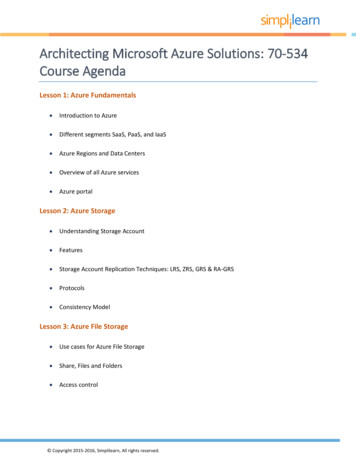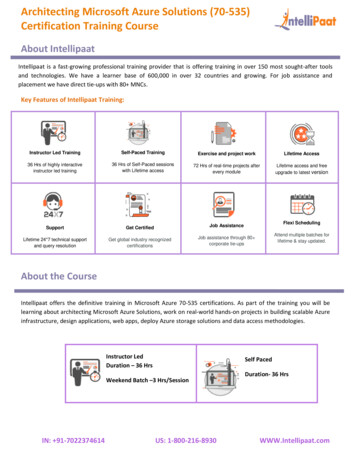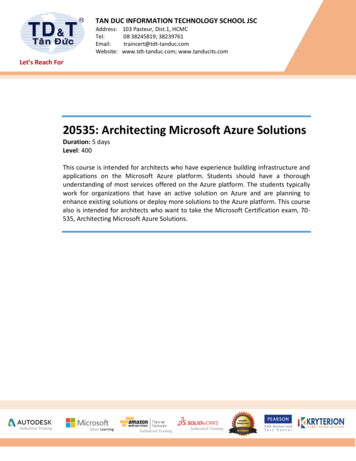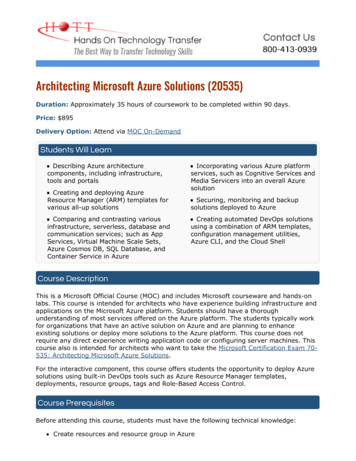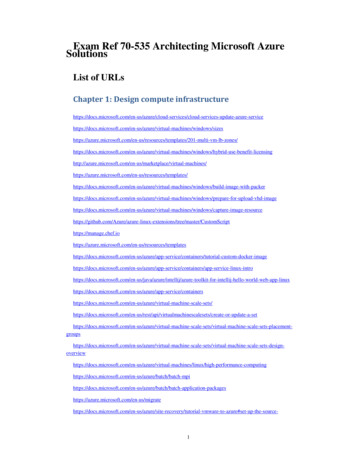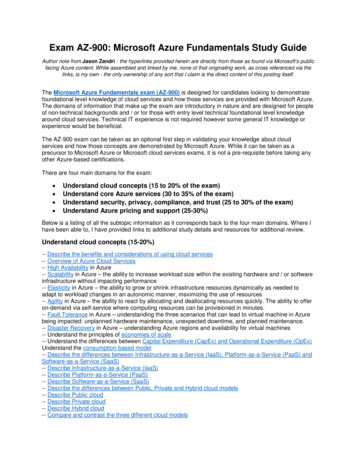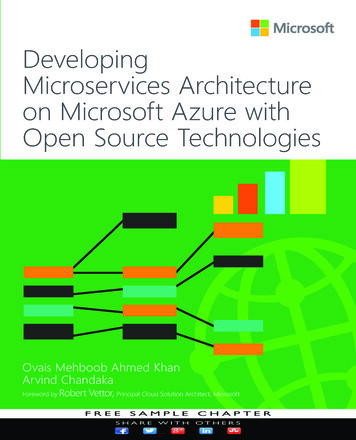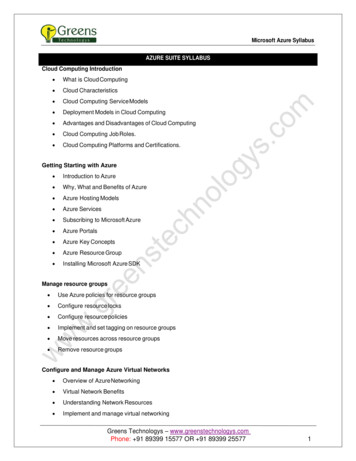
Transcription
Corporate TrainingBuild your KnowledgeCourse SpecificationsArchitecting Microsoft Azure SolutionsCourse: 20535Architecting MicrosoftAzure SolutionsThis 5 day course teaches developers and IT professionals the skills necessary to design andarchitect complex solutions for the Microsoft Azure platform. The course focuses on thestrengths and weaknesses of various Azure services and why solutions are recommended orused in various scenarios. At the end of this course, students will have the knowledge andskills to make recommendations to colleagues on design and services used in overall Azuresolutions.Duration:5 daysAudience Profile and PrerequisitesThis course is intended for students who have experience building infrastructure andapplications on the Microsoft Azure platform. Students should have a thoroughunderstanding of most services offered on the Azure platform.For the interactive component, this course offers students the opportunity to deploy Azuresolutions using built-in DevOps tools such as Azure Resource Manager templates,deployments, resource groups, tags and Role-Based Access Control.This course does not require any direct experience writing application code or configuringserver machines. This course focuses on the architectural comparisons between services andtechnical decision making needed to deploy well-designed solutions on the Azure platform.This course also prepares the students for the 70-535: Architecting Microsoft Azure Solutionscertification exam.The candidates targeted by this training have intermediate experience in designing,implementing and monitoring Azure solutions. Candidates are also proficient with the tools,techniques, and approaches used to build solutions on the Azure platform.Course OutlineModule 1: Application Architecture Patterns in AzureA Division of Micro MarketBusiness CentreKingston (Home Office)700 Progress ck.comThis module introduces and reviews common Azure patterns and architectures as prescribedby the Microsoft Patterns & Practices team. Each pattern is grouped into performance,resiliency, and scalability categories and described in the context of similar patterns withinthe category.Lessons Pattern Resources Performance Patterns Resiliency Patterns Scalability Patterns Data PatternsAfter completing this module, students will be able to: Locate and reference the Cloud Design Patterns documentation. Locate and reference the Azure Architecture Center. Describe various patterns pulled from the Cloud Design Patterns.
Corporate TrainingBuild your KnowledgeCourse SpecificationsCourse: 20535Architecting MicrosoftAzure SolutionsDuration:5 daysModule 2: Deploying Resources with Azure Resource ManagerThis module establishes a basic understanding of Azure Resource Manager and the coreconcepts of deployments, resources, templates, resource groups, and tags. The module willdive deeply into the automated deployment of resources using ARM templates.Lessons ARM Templates Role-Based Access Control (RBAC) Resource Policies Security Building BlocksLab : Getting Started with Azure Resource Manager Create Resource Groups Deploy an Empty Template Deploy a Simple Template Cleanup SubscriptionAfter completing this module, students will be able to: Create a resource group. Add resources to a resource group. Deploy an ARM template to a resource group. Filter resources using tags. Author a complex deployment using the Azure Building Blocks tools.Module 3: Building Azure IaaS-Based Server ApplicationsThis module identifies workloads that are ideally deployed using Infrastructure-as-a-Serviceservices in Azure. The module focuses on the VM Scale Sets and Virtual Machine services inAzure and how to best deploy workloads to these services using best practices and featuressuch as Availability Sets.Lessons High Availability Templated Infrastructure Domain-Connected MachinesLab : Deploying Infrastructure Workloads to Azure Deploy a Virtual Machine using PowerShell DSC Deploy a Virtual Machine Scale Set using PowerShell DSC Cleanup SubscriptionAfter completing this module, students will be able to: Design an availability set for one or more virtual machines Describe the differences between fault and update domains. Author a VM Scale Set ARM template. Join a virtualized machine to a domain either in Azure or on a hybrid network.A Division of Micro MarketBusiness CentreKingston (Home Office)700 Progress ck.com
Corporate TrainingBuild your KnowledgeCourse SpecificationsCourse: 20535Architecting MicrosoftAzure SolutionsDuration:5 daysModule 4: Creating Managed Server Applications in AzureThis module describes services that use infrastructure but manage the infrastructure onbehalf of the user instead of obfuscating the infrastructure resources. The module focuseson infrastructure-backed PaaS options such as Azure Service Fabric, Container Service, andApp Service Environments. The module will explore how to deploy custom workloads tothese services such as an HPC batch processing task.Lessons Infrastructure-Backed Platform-as-a-Service (PaaS) High-Performance Compute (HPC) MigrationLab : Deploying Managed Server Workloads to Azure Create Azure Container Service Cluster Deploy Docker Image Cleanup SubscriptionAfter completing this module, students will be able to: Describe the differences between App Service Environments, Service Fabric andContainer Service. Use Azure Batch to manage an HPC workload. Migrate to an Infrastructure-backed PaaS service from another IaaS service or alegacy Cloud Service.Module 5: Authoring Serverless Applications in AzureA Division of Micro MarketBusiness CentreKingston (Home Office)700 Progress ck.comThis module describes how solutions can leverage serverless application hosting services inAzure to host web applications, REST APIs, integration workflows and HPC workloadswithout the requirement to manage specific server resources. The module focuses on AppServices-related components such as Web Apps, API Apps, Mobile Apps, Logic Apps, andFunctions.Lessons Azure Web App Azure Functions Integration High PerformanceLab : Deploying Serverless Workloads to Azure Create Web App Deploy Web App Code Deploy Function App and Code Cleanup SubscriptionAfter completing this module, students will be able to: Select between hosting application code or containers in an App Service instance. Describe the differences between API, Mobile, and Web Apps. Integrate an API or Logic App with the API Management service. Design an App Service Plan or multi-region deployment for high performance andscale.
Corporate TrainingBuild your KnowledgeCourse SpecificationsCourse: 20535Architecting MicrosoftAzure SolutionsDuration:5 daysModule 6: Backing Azure Solutions with Azure StorageThis module describes how many Azure services use the Azure Storage service as a backingstore for other application solution in Azure. The module dives into critical considerationswhen using Azure Storage as a supplemental service for an all-up Azure solution.Lessons Pricing Blob Storage Files StorSimpleLab : Deploying Azure Storage to Support Other Workloads in Azure Create Required Resources for a Virtual Machine Create a VM With a Storage Account Create a VM With a Managed Disk Cleanup SubscriptionAfter completing this module, students will be able to: Determine the ideal pricing option for Azure Storage based on a solution’srequirements. Identify performance thresholds for the Azure Storage service. Determine the type of Storage blobs to use for specific solution components. Use the Azure Files service for SMB operations. Identify solutions that could benefit from the use of StorSimple physical or virtualdevices.Module 7: Comparing Database Options in AzureA Division of Micro MarketBusiness CentreKingston (Home Office)700 Progress ck.comThis module compares the various relational and non-relational data storage optionsavailable in Azure. Options are explored as groups such as relational databases (Azure SQLDatabase, MySQL, and PostgreSQL on Azure), non-relational (Azure Cosmos DB, StorageTables), streaming (Stream Analytics) and storage (Data Factory, Data Warehouse, DataLake).Lessons Relational NoSQL Services Azure Cosmos DB Data Storage Data AnalysisLab : Deploying Database Instances in Azure Deploy a CosmosDB Database Instance Validate the REST API Cleanup SubscriptionAfter completing this module, students will be able to: Compare and contrast various database options on Azure. Identify data streaming options for large-scale data ingest. Identify longer-term data storage options.
Corporate TrainingBuild your KnowledgeCourse SpecificationsCourse: 20535Architecting MicrosoftAzure SolutionsDuration:5 daysModule 8: Networking Azure Application ComponentsThis module describes the various networking and connectivity options available forsolutions deployed on Azure. The module explores connectivity options ranging from ad-hocconnections to long-term hybrid connectivity scenarios. The module also discusses some ofthe performance and security concerns related to balancing workloads across multiplecompute instances, connecting on-premise infrastructure to the cloud and creating gatewaysfor on-premise data.Lessons VNETs Load Balancing External Connectivity Hybrid ConnectivityLab : Deploying Network Components for Use in Azure Solutions Create an ARM Template for a Linux VM Duplicate the VM Resources Create a Load Balancer Resource Cleanup SubscriptionAfter completing this module, students will be able to: Describe DNS and IP strategies for VNETs in Azure. Compare connectivity options for ad-hoc and hybrid connectivity. Distribute network traffic across multiple loads using load balancers. Design a hybrid connectivity scenario between cloud and on-premise.Module 9: Managing Security and Identity for Azure SolutionsA Division of Micro MarketBusiness CentreKingston (Home Office)700 Progress ck.comThis module discusses both security and identity within the context of Azure. For security,this module reviews the various options for monitoring security, the options available forsecuring data and the options for securing application secrets. For identity, this modulefocuses specifically on Azure Active Directory (Azure AD) and the various features availablesuch as Multi-Factor Authentication (MFA), Managed Service Identity, Azure AD Connect,ADFS and Azure AD B2B/B2C.Lessons Security Monitoring Data Security Application Security Azure Active Directory (Azure AD) Hybrid Identity Azure AD Application IntegrationLab : Deploying Services to Secure Secrets in Azure Deploy Key Vault using ARM Template Deploy Virtual Machine using Key Vault Secret Cleanup SubscriptionAfter completing this module, students will be able to: Integrate their existing solutions with external identity providers using Azure ADB2B or B2C. Design a hybrid identity solution.
Corporate TrainingBuild your KnowledgeCourse SpecificationsCourse: 20535Architecting MicrosoftAzure SolutionsDuration:5 days Determine when to use advanced features of Azure AD such as Managed ServiceIdentity, MFA and Privileged Identity Management.Secure application secrets using Key Vault.Secure application data using SQL Database and Azure Storage features.Module 10: Integrating SaaS Services Available on the Azure PlatformThis module introduces multiple SaaS services available in Azure that are available forintegration into existing Azure solutions. These services include Cognitive Services, BotService, Machine Learning and Media Services.Lessons Cognitive Services Bot Services Machine Learning Media ServicesLab : Deploying Service Instances as Components of Overall Azure Solutions Deploy Function App and Cognitive Service using ARM Template Cleanup SubscriptionAfter completing this module, students will be able to: Identify when Cognitive Services, Bot Service or Machine Learning is appropriate fortheir solution. Compare the various features available in Media Services and determine theappropriate features for their solution.Module 11: Integrating Azure Solution Components using Messaging ServicesThis module describes and compares the integration and messaging services available forsolutions hosted on the Azure platform. Messaging services described include Azure StorageQueues, Service Bus Queues, Service Bus Relay, IoT Hubs, Event Hubs, and Notification Hubs.Integration services include Azure Functions and Logic Apps.Lessons Event Messaging Integration IoTLab : Deploying Messaging Components to Facilitate Communication Between AzureResources Deploy Service Bus Namespace Deploy Logic App Cleanup SubscriptionAfter completing this module, students will be able to: Compare Storage Queues to Service Bus Queues. Identify when to use Azure Functions or Logic Apps for integration components in asolution. Describe the differences between IoT Hubs, Event Hubs and Time Series Insights.A Division of Micro MarketBusiness CentreKingston (Home Office)700 Progress ck.com
Corporate TrainingBuild your KnowledgeCourse SpecificationsCourse: 20535Architecting MicrosoftAzure SolutionsDuration:5 daysModule 12: Monitoring and Automating Azure SolutionsThis module covers the monitoring and automation solutions available after an Azuresolution has been architected, designed and possibly deployed. The module reviews servicesthat are used to monitor individual applications, the Azure platform, and networkedcomponents. This module also covers automation and backup options to enable businesscontinuity scenarios for solutions hosted in Azure.Lessons Application Monitoring Platform Monitoring Network Monitoring Alerting Backup Azure Automation Config Management Auto-ScaleLab : Deploying Configuration Management Solutions to Azure Deploy a Chef Management Server using ARM Configure Management Server Deploy a VM Scale Set using Chef-Configured VMs Cleanup SubscriptionAfter completing this module, students will be able to: Compare and contrast monitoring services for applications, the Azure platform, andnetworking. Design an alert scheme for a solution hosted in Azure. Select the appropriate backup option for infrastructure and data hosted in Azure. Automate the deployment of future resources for backup recovery or scalingpurposes.Additional ReadingTo help you prepare for this class, review the following resources: A Division of Micro MarketBusiness CentreKingston (Home Office)700 Progress ure/architecture/
technical decision making needed to deploy well-designed solutions on the Azure platform. This course also prepares the students for the 70-535: Architecting Microsoft Azure Solutions certification exam. The candidates targeted by this training have intermediate experience in designing, implementing and monitoring Azure solutions.
